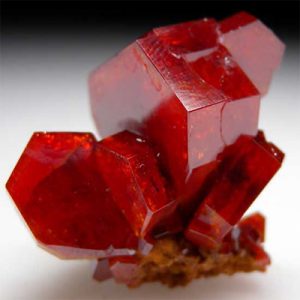Vanadinite
Vanadinite is a lead chlorovanadinate mineral that belongs to the Apatite Group of minerals that includes Apatite,Mimetite, Pyromorphite, Svabite and Vanadinite. Vanadinite is isostructural with Apatite and Pyromorphite. Isostructural means the minerals share the same crystal structure but different chemistries. It was first discovered 1838 by Señor A.M. del Rio (1764-1849), Professor, School of Mines of Mexico at Zimapán, Mun. de Zimapán, Hidalgo, Mexico. Vanadinite’s classic crystal habit is short hexagonal prisms that are wider than they are long, and terminated by a flat basal face. The high luster and deep red color make Vanadinite very appealing to gem and mineral collectors. Vanadinite is a fairly common mineral but rarely available as a faceted gem.
Vanadinite distribution: many localities, even for fine crystals. From Zimapán, Hidalgo; at San Carlos and Los Lamentos, Chihuahua; and Rayon, Sonora, Mexico. In the USA, in Arizona, fine examples from the Old Yuma mine, near Tucson, Pima County, at the Hamburg, Red Cloud, and North Geronimo mines, Silver district, La Paz County, and in the Puzzler mine, Castle Dome district, Yuma County, from the Mammoth-St. Anthony mine, Tiger, Pinal County, at the Gallagher mine, near Charleston, Cochise County, in the Apache mine, Gila County, at the Western Union mine, near Cerbat, Mohave County; in New Mexico, from the Hillsboro and Lake Valley districts, Sierra County. In Morocco, large crystals from Mibladen, at Taouz, and in the Touissit mine, near Oujda. At Keban, Turkey. Very large crystals from Abenab, Otavi district, Namibia. At Broken Hill, New South Wales, Australia.
| Chemical Formula: | Pb5(VO4)3Cl |
| Lead Chlorovanadinate | |
| Molecular Weight: | 1,416.27 gm |
| Composition: | Vanadium | 10.79 % | V | 19.26 % | V2O5 |
| Lead | 73.15 % | Pb | 78.80 % | PbO | |
| Chlorine | 2.50 % | Cl | 2.50 % | Cl | |
| — | — % | Cl | -0.56 % | -O=Cl2 | |
| Oxygen | 13.56 % | O | |||
| 100.00 % | 100.00 % | = TOTAL OXIDE |
| Crystallography: | Hexagonal – Dipyramidal |
| Crystal Habit: | Typically in well-developed hexagonal prismatic crystals, to 14 cm, short to long along [0001], with {1010}, {0001}, modified by {1120}, {1011}, {2021}, {1121}, many others. Commonly cavernous and in parallel groupings; may be acicular, hairlike, fibrous; rarely rounded, globular. |
| Twinning: | None |
| Cleavage: | None observed |
| Fracture: | Irregular/uneven, conchoidal |
| Tenacity: | Brittle |
| Moh’s Hardness: | 2.5 – 3.0 |
| Density: | 6.88 (g/cm3); density decreases with the substitution of Ca for Pb; reported values range between ~6.5 to 7.1. |
| Luminescence: | None |
| Radioactivity: | Not Radioactive |
| Other: | Readily soluble in HNO3 to a yellow solution; soluble in HCl to a green solution with the deposition of lead chloride. |
| Color: | Orange-red, red-brown, brown, bright red, yellow, whitish; pale straw-yellow; colourless or weakly tinted in transmitted light. May exhibit zoned coloration due to varying composition. |
| Transparency: | Transparent, Translucent, Opaque |
| Luster: | Sub-adamantine, resinous |
| Refractive Index: | 2.416 – 2.350 Uniaxial ( – ) |
| Birefringence: | 0.066 |
| Dispersion: | n/a |
| Pleochroism: | Weak; visible in tinted material in transmitted light |


